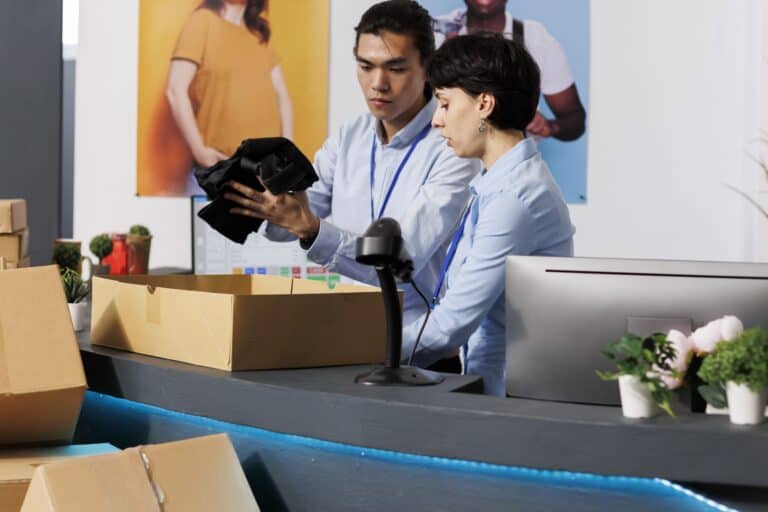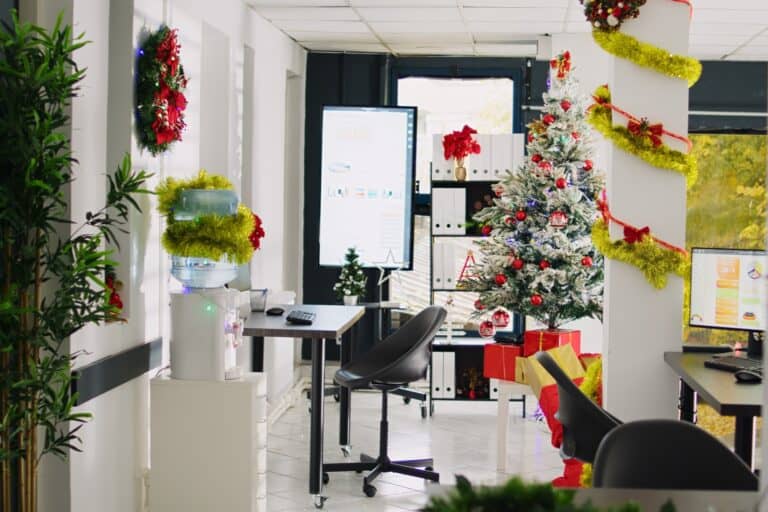Communicating an office move to clients and partners is crucial for maintaining trust and avoiding disruptions. This guide offers actionable steps on how to communicate an office move to clients and partners, ensuring your messaging is clear, timely, and effective. You’ll learn how to notify stakeholders early, craft announcements, personalise communications, and use multiple channels for the best outreach.
Key Takeaways
- Early communication about an office move helps maintain trust and manage expectations, ideally notifying clients and partners six months in advance.
- Crafting a clear and effective office relocation announcement is essential, including key details such as the new address, important dates, and reasons for the move.
- Customising communication for different stakeholders, using multiple channels, and providing clear directions are crucial for ensuring a smooth transition during the office relocation.
Notify Clients and Partners Early
When relocating an office, early communication is crucial to maintain trust and avoid confusion. Notifying clients and partners well in advance reassures them that services will remain uninterrupted and demonstrates professionalism. Ample notice, ideally six months before the move, gives clients and partners sufficient time to adjust to the new location and strengthens business relationships. For larger businesses, a notice period of four to six weeks may be sufficient to keep stakeholders informed.
Timely announcements prevent disruptions and ensure that clients and partners are well-prepared for the transition. A well-structured communication plan builds confidence and reassures clients that the move will not affect service quality. Early communication is a key takeaway for businesses planning an office move, as it underscores reliability and commitment to maintaining strong business relationships.
Keeping clients and business partners informed from the outset helps manage expectations and reduces the risk of misunderstandings. By communicating early, businesses can foster a sense of anticipation and excitement about the new office location, thereby reinforcing positive business relationships.
Crafting an Effective Office Relocation Announcement
An effective office relocation announcement is essential for clearly conveying the details of your move. This announcement should include the new office location, important dates, updated contact information, and the reasons behind the move. Highlighting specific dates related to the move sets clear expectations and helps stakeholders plan accordingly.
The announcement should prominently feature the new address to ensure it is easily noticeable. A suggested headline like ‘New Office Announcement’ can grab attention and set the tone for the message. It’s important to communicate the logistics of the move, such as the moving date and new address, in a clear and concise manner. Explaining the reasons for the move is important. It clarifies the need for more space or better facilities, allowing stakeholders to understand the rationale behind the decision.
Maintaining a positive, forward-looking tone in the announcement can help build excitement and anticipation among stakeholders. This enthusiasm not only makes the transition smoother but also reinforces the growth opportunities that come with the new office space.
The office relocation announcement serves as an official communication tool to inform customers, clients, vendors …
The office relocation announcement serves as an official communication tool to inform customers, clients, vendors, and employees, keeping everyone on the same page. By effectively crafting and disseminating the office relocation announcements, businesses can ensure a successful office move and maintain strong relationships with all stakeholders involved.
Customising Communication for Different Stakeholders
Effective communication during an office move requires adapting messages to cater to the unique needs of each stakeholder group. Customising communication is essential to address specific concerns and ensure each audience feels valued and informed. Prioritising face-to-face meetings or calls with key clients is a recommended strategy for communicating about the office move.
A senior manager should act as the move coordinator and be the dedicated contact person for any questions during the relocation. By tailoring communication strategies for different stakeholders, businesses can ensure that key messages are effectively conveyed through various communication channels. This approach enhances the effectiveness of office move communications and strengthens business relationships.
Personalising Messages for Clients
Clients should be reassured that their services will continue uninterrupted during the office relocation. It’s important to communicate the moving date, new address, and relocation details clearly to ensure clients are well-informed. Informing clients about how the new office location will enhance their experience and improve service delivery can help build excitement and confidence in the move.
Providing contact details for further inquiries ensures that clients know who to reach out to with any questions. By utilising multiple communication channels, businesses can personalise messages for clients and keep them engaged and informed throughout the relocation process.
Informing Business Partners
Business partners need clear information on how the office move will affect current projects and future collaborations. Communicating any adjustments in timelines and deliverables is crucial to ensure that business partners are aligned and can plan accordingly. Highlighting the benefits of the new office space, such as improved collaboration opportunities and enhanced productivity, can help partners understand the positive impact of the move.
Offering moving gifts can express appreciation to clients and partners for their support during the transition. By utilising multiple communication channels and involving employees in the communication process, businesses can maintain strong relationships with their partners and ensure business continuity.

Utilising Multiple Communication Channels
Using multiple communication channels is essential for ensuring comprehensive coverage and effective information dissemination regarding office relocations. A multi-channel approach increases the chances of all stakeholders receiving the necessary information about the office move. Employing various communication methods fosters reliable and extensive outreach to all stakeholders during an office relocation.
Utilising multiple communication platforms for an office move announcement provides personalisation through emails and real-time updates via social media. The use of various communication channels enhances information absorption, making key messages easier to remember.
Effective methods for announcing an office move include emails, face-to-face meetings, webinars, and posting updates on the company website. As the office move date approaches, additional communication options such as targeted desktop alerts and pop-up notifications can be utilised.
Sending Office Moving Announcement Emails
An office relocation email must include several important details. These include the new address, moving date, reasons for the relocation, benefits for employees, packing timeline, and contact information. The key components of an effective office relocation announcement email are the relocation date, new address, reasons for the move, and contact information for inquiries.
The benefits of the new office location, such as improved facilities and commuting options, should also be highlighted. Providing comprehensive information in the email reduces confusion and helps manage expectations. Contact details should be readily available to address any further inquiries. In addition, automated emails can be set up for clients contacting the old address to ensure timely relocation information is received.
Updating Your Company Website
Updated contact information and the new office address should be prominently displayed on the company website during an office relocation. Creating a dedicated section for the relocation on the company website serves as a central point for all updates regarding the office move.
This section must contain all the relevant details. Important dates, the new address, and contact information for inquiries should be included. Consider using a short video to highlight the new space and ensure these relevant details are featured prominently to minimise confusion.
Leveraging Social Media
Social media is a powerful tool to keep stakeholders informed and engaged during an office relocation. Utilising social media helps maintain transparency, provide real-time updates, and create engagement throughout the moving process. Types of updates to share on social media include images and regular updates about the relocation process, showcasing progress and highlighting the benefits of the new office.
These updates generate excitement and engagement among stakeholders, fostering a positive perception of the relocation. By leveraging multiple communication channels, businesses can ensure that their office move communications are effective and reach a wide audience.
Face-to-Face Meetings and Calls
Face-to-face meetings are crucial during an office move, as they enhance trust and directly address client concerns. Personal interactions facilitate a deeper understanding of concerns and logistics during the relocation process. Face-to-face requests during office moves are significantly more effective than emails, making them a valuable communication strategy.
Conducting meetings in person fosters a supportive atmosphere, making it easier to address client concerns effectively. Clear agendas during face-to-face meetings ensure relevant points are covered and concerns are effectively addressed. Additionally, face-to-face meetings improve communication through body language interpretation and reduce technology disruptions.
It’s important to schedule follow-up meetings with key clients post-announcement to address any lingering questions or concerns. By utilising multiple communication channels, businesses can maintain strong business relationships and ensure a smooth transition during the office move.

Providing Clear Directions to the New Office Location
Clear directions are crucial when relocating to a new office, as they facilitate a smooth transition. It’s important to communicate nearby landmarks, public transport options, and parking availability for clear directions. Mentioning accessible nearby amenities such as shops, cafes, and restaurants can enhance the appeal of the new location. In addition, utilising technology like Google Maps can assist in providing real-time traffic updates and public transport information.
A step-by-step guide is effective for navigating to the new office spaces. Providing a map detailing the route from the old office to the new location aids in navigation. Specifying the number of parking spaces available for employees ensures convenience and helps stakeholders plan their visit to the new office.
Maintaining Business Continuity During the Move
Establishing a solid business continuity plan is vital to ensure ongoing operations during an office relocation. Identifying critical business functions helps maintain essential operations throughout the relocation. A business continuity plan is crucial during an office move.
It helps ensure that service levels are maintained throughout the process. Secure data backups are crucial to protect sensitive information during the office transition. Regular testing of the business continuity plan ensures its effectiveness and relevance over time.
Collaborating with the office relocation provider can enhance the effectiveness of the business continuity strategy. To reassure clients and partners about business continuity, clear communication regarding service disruptions is essential. Regular updates should be provided to clients, outlining service arrangements during the move. Clients should be informed of any changes in service availability through clear notices on the company website.
It is crucial to maintain an appearance of control. Keeping business as usual is equally important. Providing clients with a contact person for inquiries about the move can help streamline communication and address concerns effectively. By communicating the detailed process of the office move, businesses can help clients understand and stay informed. The relocation process should include contingency plans to address unforeseen challenges that may arise.
RECOMMENDATION
To ensure a smooth transition, businesses must prioritise maintaining operations and keeping clients informed throughout the move. Clear communication, proactive planning, and a solid continuity strategy will reassure clients and partners while minimising disruptions.
Celebrating the Move
Celebrating the office move strengthens relationships, maintains trust, and creates a positive impact among clients and partners. The new office location is significant to clients as it matches their ambition and accommodates growth. Hosting events like open houses, ribbon-cutting ceremonies, and tours can effectively celebrate the office move. A grand opening party can be organised with food, drinks, and fun activities to celebrate the office move.
Including indications of local amenities enhances the appeal of the new office and increases engagement. Inviting community VIPs to the move celebration can enhance the significance of the event. Activities like providing refreshments and entertainment during the move celebration can improve attendees’ experience. Celebrating the office move helps boost team spirit and creates a sense of accomplishment and community.
Summary
Successfully communicating an office move to clients and partners involves early communication, customising messages for different stakeholders, and utilising multiple communication channels. Each step, from crafting an effective office relocation announcement to maintaining business continuity during the move, plays a crucial role in ensuring a smooth transition.
Celebrating the move can further strengthen relationships and create a sense of achievement. Embrace these strategies to turn your office move into a seamless and positive experience that excites and reassures all stakeholders.
Frequently Asked Questions
How do you communicate with clients and customers?
Effective communication with clients and customers can be achieved through various channels such as email, phone technology, social media, and web chat. Utilising a combination of these methods will enhance engagement and ensure clear messaging.
What should be included in an office relocation announcement?
An office relocation announcement should include the new office address, moving date, reasons for the move, and any benefits associated with the new location. It’s also important to provide updated contact details, directions to the new office, and information about any changes in service availability during the transition. This comprehensive approach ensures that all stakeholders are well-informed and prepared for the move.
How early should we notify our clients and partners about the office move?
Notify your clients and partners at least six months in advance of the office move to ensure they have ample time to adjust and to uphold strong business relationships.
How do you communicate professionally with clients and other professionals?
To communicate professionally with clients and other professionals, prioritise active listening and open dialogue while responding promptly and empathetically. Clear, concise communication and an awareness of nonverbal cues further enhance professional interactions.
How can we ensure business continuity during the office move?
Develop a comprehensive business continuity plan that identifies critical functions and outlines strategies to maintain operations. Secure data backups and establish communication with clients and partners about potential disruptions. Regularly update stakeholders on the progress of the move and provide a dedicated contact person to address any concerns. Collaborating with your office relocation provider and conducting regular testing of the continuity plan will further enhance its effectiveness.







